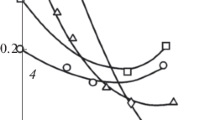Abstract
Effect of special carbides (VC, M 6C, Mo2C) on the wear resistance and friction coefficient of austenitic stable (M s below −196°C) antiferromagnetic (T N = 40–60°C) steels 80G20F2, 80G20M2, and 80G20F2M2 has been studied. The structure and the effective strength (microhardness H surf, shear resistance τ) of the surface layer of these steels have been studied using optical and electron microscopy. It has been shown that the presence of coarse particles of primary special carbides in the steels 80G20F2, 80G20M2, and 80G20F2M2 quenched from 1150°C decreases the effective strength and the resistance to adhesive and abrasive wear of these materials. This is caused by the negative effect of carbide particles on the toughness of steels and by a decrease in the carbon content in austenite due to a partial binding of carbon into the above-mentioned carbides. The aging of quenched steels under conditions providing the maximum hardness (650°C for 10 h) exerts a substantial positive effect on the parameters of the effective strength (H surf, τ) of the surface layer and, correspondingly, on the resistance of steels to various types of wear (abrasive, adhesive, and caused by the boundary friction). The maximum positive effect of aging on the wear resistance is observed upon adhesive wear of the steels under consideration. Upon friction with enhanced sliding velocities (to 4 m/s) under conditions of intense (to 500–600°C) friction-induced heating, the 80G20F2, 80G20M2, and, especially, 80G20F2M2 steels subjected to quenching and aging substantially exceed the 110G13 (Hadfield) steel in their tribological properties. This is due to the presence in these steels of a favorable combination of high effective strength and friction heat resistance of the surface layer, which result from the presence of a large amount of special carbides in these steels and from a high degree of alloying of the matrix of these steels by vanadium and molybdenum. In the process of friction, there are formed nanocrystalline austenitic structures possessing high effective strength and wear resistance on the wear surface of these steels.
Similar content being viewed by others

References
O. A. Bannykh and V. M. Blinov, Dispersion-Hardened Nonmagnetic Vanadium-Containing Steels (Nauka, Moscow, 1980) [in Russian].
L. G. Korshunov, “Structural Transformations during Friction and Wear Resistance of Austenitic Steels,” Fiz. Met. Metalloved., 74(2), 3–21 (1992) Phys. Met. Metallogr. 74 (2), 150–162 (1992)].
K.-H. Zum Gahr, “Reibung und Verschleiss eines ausscheidungs hartbaren austenitischen Stahls unter abrasiver Bedingungen,” Z. Metallkd. 68(5), 381–389 (1977).
V. V. Sagaradze and A. I. Uvarov, Strengthening of Austenitic Steels (Nauka, Moscow, 1989) [in Russian].
I. I. Kositsyna, V. V. Sagaradze, and E. N. Frizen, “Structure and Properties of Aging Mn-V-Mo Austenitic Steels with Various Carbon Contents,” Fiz. Met. Metalloved., 62(3), 556–565 (1986).
I. I. Kositsyna and V. V. Sagaradze, High-Strength Austenitic Steels with Carbon Hardening (Ural. Otd. Ross. Akad. Nauk, Ekaterinburg, 2010) [in Russian].
V. A. Kazakovtseva and M. P. Usikov, “Structure of Vanadium and Molybdenum Steels at the Stage of Formation of Special Carbides,” Fiz. Met. Metalloved. 52(4), 764–771 (1982).
V. Gerold and H. P. Karnthaler, “On the Origin of Planar Slip in F.C.C. Alloys,” Acta Metall. 47(8), 2177–2183 (1989).
H. J. Goldschmidt, Interstitial Alloys (Butterworths, London, 1967; Mir, Moscow, 1971).
M. M. Khrushchov and M. A. Babichev, Abrasive Wear (Nauka, Moscow, 1970) [in Russian].
E. Hornbogen, “Microstructure and Wear,” in Metallurgical Aspects of Wear (Bad Pyrmont, Obernsel, 1979), pp. 23–49.
L. G. Korshunov, Yu. N. Goikhenberg, N. A. Tereshchenko, A. I. Uvarov,A. V. Makarov, and N. L. Chernenko, “Wear Resistance and Surface Structure of Nitrogen-Containing Stainless Austenitic Steels upon Friction and Abrasive Wear,” Fiz. Met. Metalloved. 84(5), 137–149 (1997) [Phys. Met. Metallogr. 84 (5), 554–561 (1997)].
L. G. Korshunov and N. L. Chernenko, “The Influence of Manganese on the Wear Resistance of Metastable Austenitic Steels,” Trenie Iznos 5(1), 106–112 (1984).
L. G. Korshunov, V. V. Sagaradze, and E. I. Starchenko, “The Influence of Magnetic Transformations on the Friction and Wear Parameters of Austenitic Alloys,” Fiz. Met. Metalloved. 58(3), 586–588 (1984).
I. I. Kositsyna and V. V. Sagaradze, “Variation of Mechanical Properties and Antiferromagnetic Ordering of Manganese Austenitic Steels at Low Temperatures,” Fiz. Met. Metalloved. 68(4), 818–825 (1989).
L. G. Korshunov, V. A. Shabashov, N. L. Chernenko, and N. P. Filippova, “Effect of Antiferromagnetic Ordering on Tribologic Properties of High-Manganese Austenitic Steels,” Fiz. Met. Metalloved. 84(3), 150–160 (1997) [Phys. Met. Metallogr. 84 (3), 308–315 (1997)].
V. A. Shabashov, A. G. Mukoseev, V. V. Sagaradze, and A. V. Litvinov, “Phase Transitions in Metal-Carbide and Metal-Oxide Systems during Severe Plastic Deformation,” Izv. Ross. Akad. Nauk., Ser. Fiz. 67(7), 1041–1047 (2003).
V. A. Shabashov, A. G. Mukoseev, and B. B. Sagaradze, “Formation of Solid Solution of Carbon in BCC Iron by Cold Deformation,” Mater. Sci. Eng., A 307, 91–97 (2001).
Y. N. Dastur and W. C. Leslie, “Mechanism of Work Hardening in Hadfield Manganese Steel,” Metall. Trans. A 12(5), 749–759 (1981).
V. G. Gavrilyuk, Carbon Distribution in Steel (Naukova Dumka, Kiev, 1987) [in Russian].
L. G. Korshunov, A. V. Makarov, and N. L. Chernenko, “Nanocrystalline Friction Structures in Steels and Alloys, Their Strength and Tribological Properties,” in Development of Acad. V. D. Sadovskii’s Ideas: A Collection of Papers (Ekaterinburg, 2008), pp. 218–241 [in Russian].
Author information
Authors and Affiliations
Additional information
Original Russian Text © L.G. Korshunov, I.I. Kositsina, V.V. Sagaradze, N.L. Chernenko, 2011, published in Fizika Metallov i Metallovedenie, 2011, Vol. 112, No. 1, pp. 94–104.
Rights and permissions
About this article
Cite this article
Korshunov, L.G., Kositsina, I.I., Sagaradze, V.V. et al. Effect of the carbide phase on the tribological properties of high-manganese antiferromagnetic austenitic steels alloyed with vanadium and molybdenum. Phys. Metals Metallogr. 112, 90–100 (2011). https://doi.org/10.1134/S0031918X11010303
Received:
Accepted:
Published:
Issue Date:
DOI: https://doi.org/10.1134/S0031918X11010303


